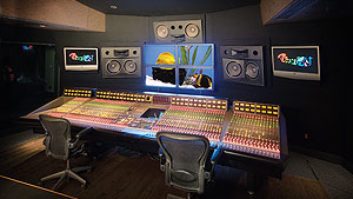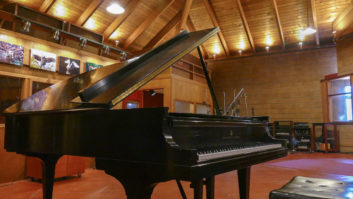I really believe that the Latin market in the U.S. is still relatively untapped. There’s something way bigger here than we can see yet.
A long time ago, I stopped thinking of myself as anyone other than the person who has to make the person on the cover of the album sound good. That’s my job—to make them shine.
The United States has long had a love affair with Latin music, and that affection is growing. Although the popularity of current teen favorites such as Ricky Martin, Christina Aguilera and Jennifer Lopez may pass, these performers will likely give way to further generations of Latin music stars. “Livin’ La Vida Loca” was perhaps the perfect novelty pop tune for the turn of the century, but behind it is a formidable force in music sales, production and creativity.
Rudy Perez is perfectly positioned to be a pivotal figure in the growing Latin-American music scene. This producer/engineer is already responsible for tens of millions in sales with his productions for Latin music stalwarts such as Jose Feliciano, Julio Iglesias, Placido Domingo, Frankie Negron, Luis Miguel and Arturo Sandoval. And he has had just as much influence on the contemporary Latin-American juggernaut. He produced teen sensation Christina Aguilera’s Spanish-language, multi-Platinum recording Mi Reflejo, and he is helping consolidate the striated Hispanic market with bicultural remixes, such as adapting Puerto Rican songstress Millie Corretger for the Mexican-American audience. He is also part of Miami’s studio industry renaissance with two Pro Tools-based studios running out of his home-based production company, Bullseye Productions.
Perez is a multitasking producer; he often composes, arranges, sings and plays on the tracks he produces. In the process, he has racked up numerous achievements and awards, including four Grammy Awards, 50 Platinum and 30 Gold albums, and 70 Top 10 hits. He has been ASCAP’s Latin Songwriter of the Year two years running; he was elected the first president of the Florida branch (now a full chapter) of NARAS, and he was instrumental in establishing the first Latin Grammy Awards, which debuted in 2000. Perez has also left his musical mark on dozens of film soundtracks, television commercials and world music specials. Did we mention the Presidential Endowment of the Arts Award?
Born in Cuba 42 years ago, Perez came to Miami with his parents, two sisters and one brother at the age of six and settled in Liberty City, one of Miami’s more notorious barrios. His success story needs to start that far back…
That childhood had a pretty significant effect on your career.
I was kind of glad that we wound up living in the projects, which was all my father could afford when we first got here. It really introduced me to music, especially R&B and gospel music. My dad was a Baptist minister, and when my mom saw all the Baptist churches in the neighborhood, she thought that was great. But these were not Cuban Baptist churches, as you might have guessed with being in Liberty City. But I had never seen or heard anything like it. The music was incredible. I got to sing in the choir and learned to play piano, guitar and drums because of the churches. Whatever instrument they needed, I learned. That led me to joining a few garage bands in the neighborhood.
Latin bands?
Actually, no. Mostly rock bands. The biggest one was called Pearly Queen, a Top 40 cover band, which got pretty hot in Miami in the days before the Miami Sound Machine [the band that launched Gloria Estefan’s career]. We landed a contract to play all of the Big Daddy Flanigan’s clubs in the U.S. and Canada—90 clubs playing five sets a night, five or six nights a week. I started when I was 15, and I turned 18 in those clubs. That was where I went to school, in those clubs. Playing cover songs taught me how pop songs were arranged and played. Now I wanted to know how they were recorded.
When did you decide you wanted to produce records and work in the studio?
I was producing some local Latin artists in Miami after I came off the road, as well as writing songs for them.
You were in Miami, which had become famous for being the base for musicians like Eric Clapton and the Bee Gees, as well as studios like Criteria. Yet you were working in the Latin world. Did those two domains interact in the studio?
They didn’t. Back in those days, there may have been Latin musicians all over Miami, but not a lot of them were recording there. I started working as a gofer at Miami Sound Studios, which was owned by Carlos Granados, whose father was a legendary record guy. He pressed the first record ever made in Colombia. Bob Marley and Wild Cherry used to record there. It was the competition to Criteria in the late ’70s. It had an old, old Neve 1073 console. After I got my initial experience there, I moved over to Climax Recording in north Miami on 30th Street. I used to sleep there, because I was just going through a divorce. I would record my own songs there and do demos for my friends’ bands. One day, the owner, Pablo Cano, came in and heard this ballad I had written. He said, “Who’s that?” I told him it was me, and he freaked out and said we have to do a real record. We did, and he brought it over to Jose Menendez, who was then at RCA Records, who signed me to a contract.
Here’s where how I became a real producer comes in, though. I had written a ballad—“Que Voy a Ser Sine Ti?” [“What Am I Going to Do Without You?”]—and Pablo hired this arranger to work it up, with strings and everything. I came into the studio, heard the arrangement and told Pablo that that’s not the way I heard the song. We went back and forth about it, but finally Pablo said, “Let’s do it your way.” We did, and that record did okay on the radio with me as the artist, in 1983. But while I was on a promotional tour for it, I was in Puerto Rico and met José Feliciano. I had to tell him what a big fan I was of his music. Well, it turns out that Menendez had played him my version of “Que Voy a Ser Sine Ti?” and when he found out I was the writer and producer, [Feliciano] said right there, “I want you to produce my next record.” He said he loved the arrangement of the song. If I had let someone else produce it, if I had not followed my musical instincts, I never would have had the career I’ve had, my destiny would have been very different, because that record I did with José opened up all the doors for me. It won two Grammy Awards, for the album and the song “Por Ella,” which José did as a duet with Jose Jose. That’s what I try to teach any young person who works with me: Always follow your instincts. You told me that you did that record over the initial objections of Feliciano’s manager, which was understandable considering you had no track record and you were being asked to produce one of the pop world’s biggest stars. When you flew to L.A. to do the record, were you intimidated?
Very! But as a musician, I was always into reading the [album] credits, and I knew the guys I wanted to work with, like David Foster and Robby Buchanan and Mike Landau, and the studios, like Sunset Sound and Ocean Way and Conway. I knew I was walking through big doors. But José was really behind me as the producer, and I got to work with great engineers, like Mick Guzauski, who was sleeping on a mattress under the console at Conway.
I have to ask this question about working with José Feliciano. How do you keep a blind singer on mic?
We used to tape a music stand in front of him so he knew that when he grabbed both sides of it, the microphone was in the middle. But also I was always in the booth with him when he sang, not in the control room. He liked the vibe of me being out there with him, and the engineer appreciated having someone keep José centered on the mic, ’cause when he starts singing he really gets to rocking around.
What mics did you like on José?
José has a very sharp and powerful midrange. So I would try to warm it up with a tube [Neumann] U87 or U47, sometimes a U49.
Working with Feliciano led to a whole succession of calls from great Latin artists. What’s it like working in the studio with Julio Iglesias? He seemed to love the studio—he had his own lounge at Criteria for years…
Julio really suffers in the studio, because he is such a perfectionist. He can’t always explain what he hears in his head, so he just keeps going on and on until he finds it. And you’d think it would drive you crazy to have to be in the studio with him during all of this. But the truth is, you can see how much he suffers to achieve what he wants, and all you want to do is make this man happy by helping him find what he’s looking for in the music. So when people say to me, “You produced Julio,” I say, “No one ever produces Julio. We are only there to capture his moments.” He’s sold 200 million records doing it that way.
And Arturo Sandoval? He seems like such an inspired madman onstage; what’s he like in the studio?
Pretty intense there, too. I did the I Remember Clifford record with him [a tribute to jazz trumpeter Clifford Brown], and I remember watching him play four trumpet parts in harmony on one track, and that was after he had transcribed all the solos. Punching in overdubs on these parts is more than just engineering; he’s playing at 380 bpm, and he says to you, “Punch me in on the third beat of the fourth bar.” It’s almost magical getting those punches. It’s not about just having good ears. That’s one of the reasons I engineered and produced that record. You have to have good time as well as being musical. Musicians at Arturo’s level don’t tolerate people who can’t make those punches the first time, because great musicians will usually give you the best stuff on the first take, and they don’t like to have to play it twice. That’s another thing I try to teach young engineers I work with: to learn some sense of rhythm. Don’t just be punching in on the downbeat, especially in Latin music, where there is much syncopation.
Christina Aguilera is one of the teen idols of the new Latin movement. But she’s not Latina in the way the previous generation of Latin artists were, is she? You mentioned her mother is American and that her Spanish is far from perfect. People still say a record’s not country if it’s not made in Nashville or if the artist isn’t wearing a hat. In this changing demographic, what makes an artist Latin or not?
When I met her, I asked [RCA A&R person] Ron Fair if she can speak Spanish, and he says, “Not really.” She could once; her father was from Ecuador and her mother was American, but they separated. I knew she could sing, though. That’s for sure. The thing that makes the difference is the Hispanic last name. That makes a big difference for Latino. If you’re Celine Dion, that’s great. But that doesn’t mean you can sell records to Hispanics. If she was named Celine Rodriguez…
So you were brought in to produce the Spanish-language record for Aguilera. That’s not unusual now; Ricky Martin has done separate albums for Anglo and Hispanic markets. But is this a kind of musical segregation? And does it limit you as a producer?
Not at all. I told Ron, if you did an album in Spanish with this girl, she would kill in Spanish. She had to work hard on pronunciation, and she has Spanish lessons every day. But this is a generation that’s bicultural. These are not Argentineans or Mexicans. These are the children of immigrants, and they are connecting to their Latin roots in a different way. Christina is an example of that. As for limiting me as a producer, no way. The Anglo record had several producers; I was the only one on the Spanish record. And I got to spend a year working on it with her.
Do you see yourself being used to legitimize her to the Latin market?
Perhaps the record label does, but I know it works in both directions. I worked with [contemporary Christian artist] Jaci Velasquez. I crossed her from English to Spanish. She’s another artist with a Hispanic name but who doesn’t speak it. You need someone who can work in both languages. A producer specializing in Spanish only would be totally lost in the pop [idiom]. A long time ago, I stopped thinking of myself as anyone other than the person who has to make the person on the cover of the album sound good. That’s my job—to make them shine. With Millie, who is from Puerto Rico, I realized that we were not getting onto the Ranchero [Mexican] stations in the U.S., of which there are something like 3,000, and they report to Billboard. So I said let me take a crack at it. I took a click track and built a Mexican-sounding track around her, and we had a big hit in that market: It went Number One for four weeks. Thank God for this new bicultural audience. I really believe that the Latin market in the U.S. is still relatively untapped. There’s something way bigger here than we can see yet. When I was president of the Florida branch of NARAS, we commissioned a study that indicates the growth of Latin is unstoppable. By 2007, we’ll have 75 million Latinos in the U.S. [The study shows that] for every 10 records sold here, at least four will be in Spanish. Those are big numbers, and they became the basis of the Latin Grammy Awards.
You love your Pro Tools setups. But do you also use commercial studios?
I use Crescent Moon and Hit Factory Criteria and Middle Ear. I like Digi-Note, which is a Pro Tools studio [on South Beach]. I thank God for Pro Tools. I can go out and play God with audio. If I miss analog, I just record some on tape and transfer it to hard disk.
Do you still do a lot of engineering?
I had to let a lot of that go. It takes too much out of you. I want to spend more time on songwriting. But I have a great engineer now named Bruce Weeden, who comes out of that Philadelphia sound. He keeps it very half and half, not using the plug-ins but using lots of outboard compressors and signal processors. Once I found Bruce, I knew I could quit engineering.
Some day, all producers will work from home. At the end of the day, the important thing is that you spend time with the project, not with the studio. When a producer owns the studio, the project wins in the end.
Dan Daley is Mix’s East Coast editor.






